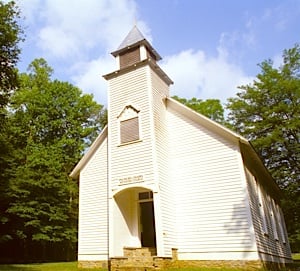Shared by Tennessee and North Carolina, Great Smoky Mountains National Park stretches for more than 521,000 acres (210,841 hectares) in the rumples of the Southern Appalachians. The park is easily one of the National Park Service's largest properties east of the Mississippi, so it is no wonder that many first-time visitors are overwhelmed. Here's the Traveler's Checklist to help make your trip planning easier.

Cades Cove Road, Great Smoky Mountains National Park / NPS file
1. View the natural history exhibits and park film in the Sugarlands Visitor Center near Gatlinburg. The 3-D model of the park and stuffed bear and turkey are always interesting. Plus, this is a great place to load up on interpretive guides, maps, and souvenirs. Plan to arrive at Sugarlands before 10 a.m. to beat the crowds.
2. Bike the Cades Cove Loop Road on Wednesday or Saturday morning. Park officials close the area's most popular 11-mile (18 km) drive to automobiles until 10 a.m. for cyclists to enjoy the moderate trip past historic log cabins, orchards, and beautiful mountain vistas. If you're lucky, you'll see wild turkey, white-tailed deer, or even black bear.
3. Head away from the crowds and pack a picnic for lunch in Greenbrier Cove, an easy drive from Gatlinburg. After your meal, enjoy an easy hike to Fern Falls, along the Porters Creek trail. You'll follow the bubbling, gurgling creek for 1.8 miles (3 km), past splendid wildflowers, old stone walls, and an old homestead with a cemetery, barn, and other structures (find the buildings by going 0.1 mile (0.2 km) up the Brushy Mountain trail at its junction with Porters Creek).

A view of the water at the Deep Creek Campground, Great Smoky Mountains National Park / NPS file
4. Escape the summer heat at the Deep Creek Campground near Bryson City, North Carolina. The campground, a favorite of locals, boasts outstanding fishing, tubing, and waterfalls on its namesake waterways. Visit the Abrams Creek Campground for a similar experience in Tennessee.
5. Immerse yourself in human history in Cherokee, North Carolina. First, stop in at the Oconaluftee Visitor Center and visit the park's excellent Mountain Farm Museum, often the site of hands-on Junior Ranger programs and demonstrations. Next, walk the 1.5 mile (2.4 km) Oconaluftee River Trail to view the wayside exhibits detailing local Cherokee and Native American history. After lunch, stop at the Museum of the Cherokee People to learn more about the first residents of the mountains.

Palmer Chapel in the Cataloochee Valley
Kurt Repanshek photo
6. Trek out to the Cataloochee Valley in North Carolina to view the Smokies' elk herd. Cataloochee, often compared to Tennessee's Cades Cove, was once a thriving settlement, so be sure to take the time to see the churches and homes that are left in the valley, accessible via gravel roads from Interstate 40.
7. Hike to the fire towers atop Mt. Cammer or Mt. Sterling. Both are steep hikes (the 2 miles up to Mt. Sterling are rumored to be the steepest in the park), but the views from the crest of the Smokies are unparalleled.
8. Keep your eyes peeled on park roads for Quiet Walkways. These short, rarely used paths will ramble alongside a creek or perhaps along a stone fence to an old cemetery, and are among the Smokies' best-kept secrets. None of these paths are named, and you have to watch carefully for the small signs, but there are several within a five-minute drive of Gatlinburg along Newfound Gap and Little River Roads (going towards Cherokee and Cades Cove, respectively).
9. Visit Great Smoky Mountains National Park in the winter and day hike in the high country. The winter temperatures and weather confines the Smokies' notorious air pollution to the valleys, rewarding day hikers with the best views of the year. Try the Appalachian Trail at Newfound Gap for an easy wintertime stroll.
10. Head up to Clingman's Dome, the highest point in the park and tallest peak in Tennessee for views from the Observation Tower. It is a steep, half-mile walk up to the Tower. Plan to arrive early to beat the crowds and summer haze. On your way back down, stop at Andrews Bald. Balds are a unique environment found in the upper reaches of the Southern Appalachians, and you won't want to miss the 3.5 mile (5.6 km) round-trip to it via the Forney Ridge Trail. Once on the bald, you'll be treated to more panoramic views of the Smokies, along with gorgeous azalea and rhododendron blooms if you come during late spring or early summer.





